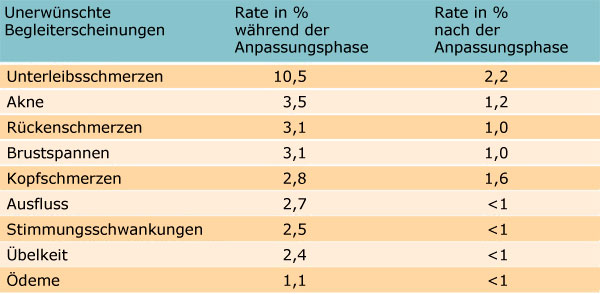Possible Disadvantages
The hormonal IUS is generally well tolerated. Only a small amount of hormone is necessary for very reliable contraception. The dosage is lower than the pill or 3-month injection, as it works directly in the uterus.
During the 3-6 month adjustment phase after inserting the IUS, side effects such as mild abdominal pain, headaches, breast tenderness, nausea, acne, or mood swings can sometimes occur. These symptoms decrease significantly after the adjustment phase. The following table shows the frequency of side effects in the adjustment phase and thereafter.

(Source: Andersson K, Odlind V, Rybo G. Contraception 49: 56-72, 1994)
Of 100 women with an IUS, after the adjustment phase:
- 2 women have abdominal pain – 98 women have no lower abdominal pain.
- 1-2 women have headaches – 98-99 women have no headaches.
- 1 woman has mood swings – 99 women have no mood swings.
- 1-2 women have acne – 98-99 women have no acne.
Since the effects of the IUS are confined mainly to the uterus, women continue to ovulate and the cycle with its fluctuations is maintained. In women who suffered from cyclical mood swings before inserting the IUS (e.g., premenstrual syndrome), the IUS will have little effect. Mood swings can occur if women took the pill beforehand and it was counteracting the cyclical fluctuations. In many cases, however, the life situation of women has more influence on the psyche than the hormonal contraceptive. Factors such as stress, partnership problems, and unresolved conflicts will influence personal well-being. The hormonal IUS alone rarely triggers an emotional imbalance.
If you already had skin problems before inserting an IUS, they will probably continue with the IUS. If you were previously taking the pill and it had a positive effect on your skin, you should be aware that the IUS does not contain estrogen and is therefore unlikely to have a skin-enhancing effect.
The frequency of ovarian cysts depends on the diagnostic method used. Clinical studies have found enlarged follicles in 12% of hormonal IUS users. Most follicles are harmless, do not cause discomfort, and usually regress alone.
Complications with the IUS are rare. If pain occurs, the IUS may not be correctly positioned. Unexpected heavy menstruation or abdominal pain can be signs of a very rare ectopic pregnancy (the growth of a fertilised egg outside the uterus) or injury to the uterus. Studies show that 10,000 women who have used the IUS for more than 1 year have had 2 ectopic pregnancies. This is just as rare as in women who are sterilized.